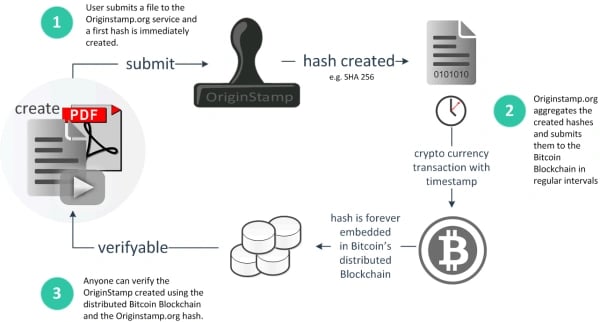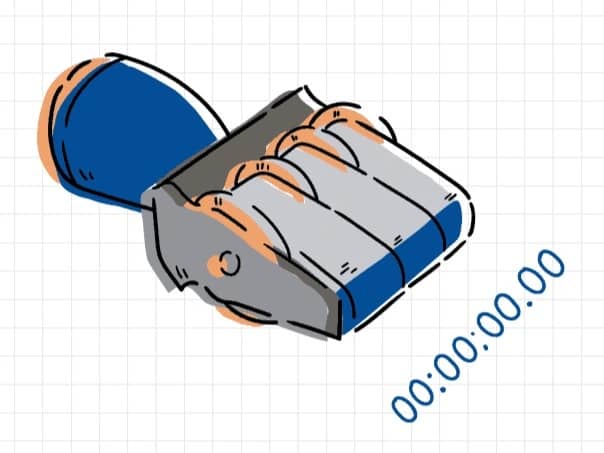Subscribe to wiki
Share wiki
Bookmark
Timestamp
The Agent Tokenization Platform (ATP):Build autonomous agents with the Agent Development Kit (ADK)
Timestamp
Blockchain-based Timestamping is the process of recording data on a blockchain to prove that it existed at a specific date and time. Blockchain-based Timestamping services are an innovative way for businesses to provide proof of existence for their documents. It is also used by organizations for tracking legal contracts, patents, and other vital records.
A timestamp record is a digital signature of the sender or receiver on a document, which can be verified against public key infrastructure (PKI).[1]
Overview

Blockchain-based timestamping is a system to verify data and assign a time or date of creation for digital documents or events.
In the simplest form, the timestamp is a string of characters that uniquely identifies the document or event and indicates when it was created.
Blockchains are decentralized systems that record data in blocks on a ledger. The blocks contain information on transactions between users on the blockchain platform. Each block must have a unique identifier. The hash function provides this identifier by converting an input value to an output value with a fixed number of digits or bits.
Blockchain-based timestamping improves the security of digital timestamping, as it generates timestamps for data, which are then stored in the blockchain. This innovation enhances the security of digital timestamping by generating timestamps for data and securing them on a decentralized network instead of just storing them on a simple computer server.
Blockchain-based timestamps have several key benefits;
- They are more reliable and secure, as they cannot be changed or removed once published to the ledger.
- Blockchain is decentralized, which minimizes the possibility of tampering by any one party.
- Timestamps can be viewed entirely transparently if desired.
An easy way to compare traditional timestamping to blockchain-based timestamping is to look at the example of a manufacturing company. Ordinarily, a manufacturing company tracks the different steps in the manufacturing process on their own centralized servers. Here data can be lost, corrupted or manipulated, potentially leading to mistrust in the timestamps. On the other hand, with its decentralized, distributed networks, blockchain secures encrypted data at the source in a way that can't be altered. With secure, immutable, transparent data comes trust, and that is where the ultimate benefit lies.
History
Post stamps and Anagram
Timestamping is not an idea that appeared in the 21st century for the first time. In fact, people have historically searched for ways to securely track and authenticate documents. Post stamps are viewed to be the precursor and first utilization of timestamping but in a very crude way.
The first ‘real’ time people tried to claim ownership over documents was in the 17th century. A number of scientists attempted to patent or prove ownership over their innovative findings by sending letters to themselves. For example, Robert Hooke published an anagram in 1660 as proof of his discovery of Hooke’s Law.
“Hooke first announced his law of elasticity as an anagram. More than ten years later, famous scientist Isaac Newton similarly sought to protect his ideas through telegrams. In a letter to Leibniz in 1677 where he explained his ‘Fluxional Technique,’ the scientist concealed his discovery by encrypting it.
Centralized infrastructures for timestamping
With the arrival of computers, we had the chance to see one of the first real implementations of timestamping. However, none of these methods were secure enough. A major problem was that they required a centralized infrastructure. These systems inherently lead to data manipulation in spite of using complex methods for encrypting timestamps. The only way to solve this problem was through decentralization, and blockchain networks are the only practical implementation of decentralized timestamping so far.
Blockchain
Blockchain technology has the potential to completely replace traditional public notaries, which are far too inefficient to process large amounts of information. Their digital versions appeared for the first time in the early 1990s in the form of e-notaries. However, neither an e-notary nor modern public notaries have the properties that could make data authorization, procurement, and processing safe or cost-efficient. Blockchain-based timestamping originally came with the creation of Bitcoin. Its blockchain network made it possible to create timestamps for every transaction within the ledger. This enables a sort of Proof of Existence where we know exactly at what point a transaction was created and what it contained.[2]
Timestamping Process
Blockchain-based Timestamping is the process of digitally signing a document, which can be verified for its accuracy against public key infrastructure (PKI). In simple terms, Blockchain-based Timestamping records the date and time when a document was signed digitally, providing proof of the document's creation.
Blockchain timestamping is used to verify data and assign a time or date of creation for digital documents or events. The simplest form used for this is a string of characters that uniquely identifies the document or event and indicates when it was created. Each block on a blockchain contains information on transactions between users on that blockchain. This block must have an identifier, and the hash function provides this identifier by converting an input value to an output value with a specific number of digits.
The document itself won’t be visible on the blockchain. A hash is a unique, unintelligible, alphanumeric value generated by performing an algorithmic action on a string or a collection of strings. Hashing is a strictly one-way, irreversible process. The signed and unsigned versions of the same document will generate different hash values. Adding the signed document’s hash to the blockchain does not expose the document data or its contents to those accessing the blockchain. It simply allows them to note down the hash value for verification of document authenticity.[3]
Application
The value and use cases for this kind of decentralized and immutable timestamping are limitless. The adoption of blockchain-based timestamping can already be seen across multiple sectors and industries worldwide. It can be used for governance, trading, payments, insurance, supply chains, and much more.
Logistics & supply chain
The supply chain is full of important events, and consumers are increasingly interested in where products come from and how they're made. Blockchain-based timestamps can be used within supply chains to improve transparency, accuracy and accountability.
Cross-Border payment systems
In recent years, cross-border payment companies have expressed their interest in adopting blockchain technology to provide faster interbank payments. For example, the largest global banking ecosystem SWIFT plans to use blockchain technology to provide 24-hour payment and clearing capabilities.
With cryptographically-encrypted timestamps, blockchain technology solves the issue of double-spending, where a user spends the same assets more than once. Therefore, it is possible to use decentralized technology to support faster and more cost-efficient global payments.
Insurance
Fraud has a major impact on the insurance industry, with opportunistic fraudsters and criminal enterprises costing the industry vast sums of money. Blockchain timestamping can help eliminate fraud by securing data at the source and providing an indisputable record of claim events, such as property damage or car crashes.
Intellectual property & copyright
Blockchain timestamps provide an immutable history that can't be doubted. When it comes to IP and copyright, having irrefutable evidence of when you created your work is critical in the case of infringement.
Legal & law
The legal and law industries rely on the security of sensitive, valuable data. Whether it is a notarial certificate or evidence in a court of law, establishing continuity and authenticity is vital. Blockchain technology ensures the provenance of information is secured in a way that can't be tampered with, manipulated or destroyed, solving many issues in the legal system.
Inspection & facility management
When dealing with complex systems or construction processes, inspections are crucial to providing safety and accountability. Facility Managers can use blockchain-based timestamps to create an immutable record of an inspection being executed the right way.
Voting
Voting is also being digitalized in numerous countries. To make the process secure and transparent, it is extremely important to use the right technology. Blockchain networks can fight against manipulation and voter fraud, as well as track the number of eligible voters.
Since modern digital voting systems are often susceptible to manipulation and hacks, it would be useful to adopt blockchain technology. On that account, the election process could be fully determined by voters who reach consensus on a public or private network. With timestamps, a citizen could also have proof that he voted during the last elections, for example, and that his vote was not manipulated.
See something wrong?
The Agent Tokenization Platform (ATP):Build autonomous agents with the Agent Development Kit (ADK)
